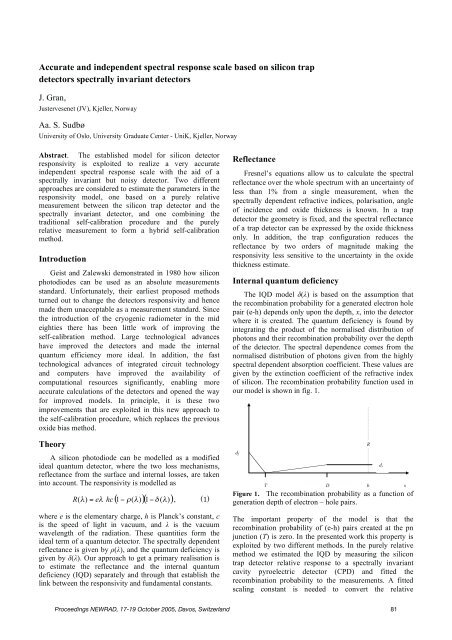Here - PMOD/WRC
Here - PMOD/WRC
Here - PMOD/WRC
Create successful ePaper yourself
Turn your PDF publications into a flip-book with our unique Google optimized e-Paper software.
Accurate and independent spectral response scale based on silicon trap<br />
detectors spectrally invariant detectors<br />
J. Gran,<br />
Justervesenet (JV), Kjeller, Norway<br />
Aa. S. Sudbø<br />
University of Oslo, University Graduate Center - UniK, Kjeller, Norway<br />
Abstract. The established model for silicon detector<br />
responsivity is exploited to realize a very accurate<br />
independent spectral response scale with the aid of a<br />
spectrally invariant but noisy detector. Two different<br />
approaches are considered to estimate the parameters in the<br />
responsivity model, one based on a purely relative<br />
measurement between the silicon trap detector and the<br />
spectrally invariant detector, and one combining the<br />
traditional self-calibration procedure and the purely<br />
relative measurement to form a hybrid self-calibration<br />
method.<br />
Introduction<br />
Geist and Zalewski demonstrated in 1980 how silicon<br />
photodiodes can be used as an absolute measurements<br />
standard. Unfortunately, their earliest proposed methods<br />
turned out to change the detectors responsivity and hence<br />
made them unacceptable as a measurement standard. Since<br />
the introduction of the cryogenic radiometer in the mid<br />
eighties there has been little work of improving the<br />
self-calibration method. Large technological advances<br />
have improved the detectors and made the internal<br />
quantum efficiency more ideal. In addition, the fast<br />
technological advances of integrated circuit technology<br />
and computers have improved the availability of<br />
computational resources significantly, enabling more<br />
accurate calculations of the detectors and opened the way<br />
for improved models. In principle, it is these two<br />
improvements that are exploited in this new approach to<br />
the self-calibration procedure, which replaces the previous<br />
oxide bias method.<br />
Theory<br />
A silicon photodiode can be modelled as a modified<br />
ideal quantum detector, where the two loss mechanisms,<br />
reflectance from the surface and internal losses, are taken<br />
into account. The responsivity is modelled as<br />
( 1<br />
(<br />
)<br />
)( 1<br />
( ))<br />
R ( )<br />
= e<br />
hc<br />
, (1)<br />
where e is the elementary charge, h is Planck’s constant, c<br />
is the speed of light in vacuum, and is the vacuum<br />
wavelength of the radiation. These quantities form the<br />
ideal term of a quantum detector. The spectrally dependent<br />
reflectance is given by (), and the quantum deficiency is<br />
given by (). Our approach to get a primary realisation is<br />
to estimate the reflectance and the internal quantum<br />
deficiency (IQD) separately and through that establish the<br />
link between the responsivity and fundamental constants.<br />
Reflectance<br />
Fresnel’s equations allow us to calculate the spectral<br />
reflectance over the whole spectrum with an uncertainty of<br />
less than 1% from a single measurement, when the<br />
spectrally dependent refractive indices, polarisation, angle<br />
of incidence and oxide thickness is known. In a trap<br />
detector the geometry is fixed, and the spectral reflectance<br />
of a trap detector can be expressed by the oxide thickness<br />
only. In addition, the trap configuration reduces the<br />
reflectance by two orders of magnitude making the<br />
responsivity less sensitive to the uncertainty in the oxide<br />
thickness estimate.<br />
Internal quantum deficiency<br />
The IQD model () is based on the assumption that<br />
the recombination probability for a generated electron hole<br />
pair (e-h) depends only upon the depth, x, into the detector<br />
where it is created. The quantum deficiency is found by<br />
integrating the product of the normalised distribution of<br />
photons and their recombination probability over the depth<br />
of the detector. The spectral dependence comes from the<br />
normalised distribution of photons given from the highly<br />
spectral dependent absorption coefficient. These values are<br />
given by the extinction coefficient of the refractive index<br />
of silicon. The recombination probability function used in<br />
our model is shown in fig. 1.<br />
d f<br />
T<br />
Figure 1. The recombination probability as a function of<br />
generation depth of electron – hole pairs.<br />
The important property of the model is that the<br />
recombination probability of (e-h) pairs created at the pn<br />
junction (T) is zero. In the presented work this property is<br />
exploited by two different methods. In the purely relative<br />
method we estimated the IQD by measuring the silicon<br />
trap detector relative response to a spectrally invariant<br />
cavity pyroelectric detector (CPD) and fitted the<br />
recombination probability to the measurements. A fitted<br />
scaling constant is needed to convert the relative<br />
D<br />
R<br />
b<br />
d r<br />
x<br />
Proceedings NEWRAD, 17-19 October 2005, Davos, Switzerland 81
















